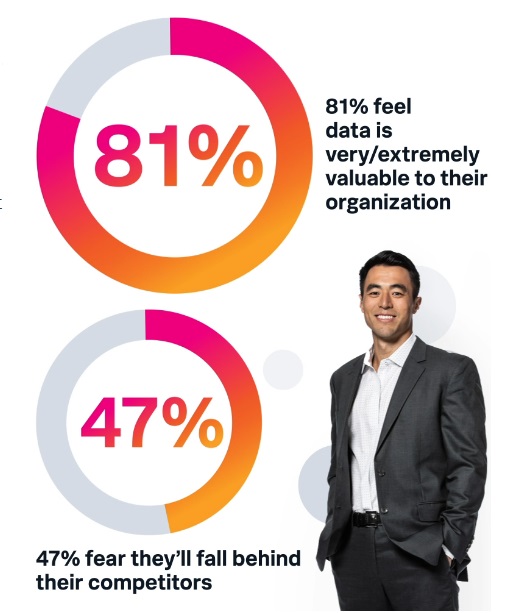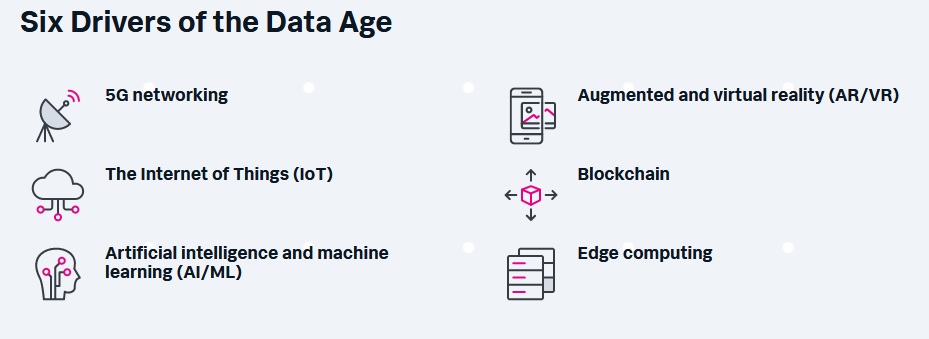
Two-thirds (67%) of those surveyed expect the sheer quantity of data to grow nearly five times by 2025, according to a new report from Splunk: The Data Age Is Here. Are You Ready?
The research shows that leaders see the significant opportunity in this explosion of data and believe data is extremely or very valuable to their organization in terms of: overall success (81%), innovation (75%) and cybersecurity (78%).

The vast majority of survey respondents (81%) believe data to be very or highly valuable yet the majority (57%) fear that the volume of data is growing faster than their organizations' ability to keep up.
"The Data Age is here. We can now quantify how data is taking center stage in industries around the world. As this new research demonstrates, organizations understand the value of data, but are overwhelmed by the task of adjusting to the many opportunities and threats this new reality presents," said Doug Merritt, President and CEO, Splunk. "There are boundless opportunities for organizations willing to quickly learn and adapt, embrace new technologies and harness the power of data."
The Data Age has been accelerated by emerging technologies powered by, and contributing to, exponential data growth. Chief among these emerging technologies are Edge Computing, 5G networking, Internet of Things (IoT), Artificial intelligence and machine learning (AI/ML), Augmented and virtual reality (AR/VR) and Blockchain. It's these very same technologies that nearly half (49%) of those surveyed expect to use to harness the power of data, but across technologies, on average, just 42% feel they have high levels of understanding of all six.

Data Is Valuable, and Data Anxiety Is Real
To thrive in this new age, every organization needs a complete view of its data — real-time insight, with the ability to take real-time action. But many organizations feel overwhelmed and unprepared. The new study quantifies the emergence of a Data Age as well as the recognition that organizations have some work to do in order to use data effectively and be successful.
■ Data is extremely or very valuable to organizations in terms of: overall success (81%), innovation (75%) and cybersecurity (78%).
■ And yet, 66% of IT and business managers report that half or more of their organizations' data is dark (untapped, unknown, unused) — a 10% increase over the previous year.
■ 57% say the volume of data is growing faster than their organizations' ability to keep up.
■ 47% acknowledge their organizations will fall behind when faced with rapid data volume growth.
Some Industries are More Prepared Than Others
The study quantifies the emergence of a Data Age and the adoption of emerging technologies across industries, including:
■ Across industries, IoT has the most current users (but only 28%). 5G has the fewest and has the shortest implementation timeline at 2.6 years.
■ Confidence in understanding of 5G's potential varies: 59% in France, 62% in China and only 24% in Japan.
■ For 5 of the 6 technologies, financial services leads in terms of current development of use cases. Retail comes second in most cases, though retailers lag notably in adoption of AI.
■ 62% of healthcare organizations say that half or more of their data is dark and that they struggle to manage and leverage data.
■ The public sector lags commercial organizations in adoption of emerging technologies.
■ Manufacturing leaders predict growth in data volume (78%) than in any other industry; 76% expect the value of data to continue to rise.
Some Countries are More Prepared Than Others
The study also found that countries seen as technology leaders, like the US and China, are more likely to be optimistic about their ability to harness the opportunities of the Data Age.
■ 90% of business leaders from China expect the value of data to grow. They are by far the most optimistic about the impact of emerging technologies, and they are getting ready. 83% of Chinese organizations are prepared, or are preparing, for rapid data growth compared to just 47% across all regions.
■ US leaders are the second most confident in their ability to prepare for rapid data growth, with 59% indicating that they are at least somewhat confident.
■ In France, 59% of respondents say that no one in their organization is having conversations about the impact of the Data Age. Meanwhile, in Japan 67% say their organization is struggling to stay up to date, compared to the global average of 58%.
■ UK managers report relatively low current usage of emerging technologies but are optimistic about plans to use them in the future. For example, just 19% of UK respondents say they are currently using AI/ML technologies, but 58% say they will use them in the near future.
Methodology: The report is based on research conducted by TRUE Global Intelligence and directed by Splunk, who surveyed 2,259 global business and IT managers from the US, France, China, Australia, UK, Germany, Japan and the Netherlands.
